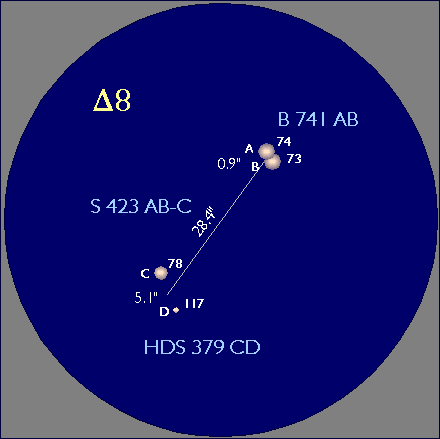by Dave Blane — 2013 November 20

Dunlop 8 in Fornax.
Dunlop 8 (02572-2459) is an interesting multiple star that offers different challenges to users of 150mm and larger telescopes.
Located in a fairly unremarkable field it may be found some 37′ NE of Zeta (ζ) Fornacis or 02h58m18s -24deg57m for the GOTO users.
James South first discovered the wide pair (AB-C) in 1824 and it was then found independently by Dunlop in 1828. In Dunlop’s defence, he had no real means of knowing that it had been previously found, and he lists the pair as 41 Applied Chemici – in the now defunct southern constellation of the Applied Chemical Furnace.
Although wide, the 1954 position for this pair has increased from 27.7 to 28.4 arcsec while the PA has increased from 219° to 224°. Visual magnitudes are 7.3 and 7.8 but were noted by Dunlop as “7.7”. Unfortunately he never recorded any initial micrometric measures of the wide pair.
Closer inspection reveals that the brighter component is also double. This was discovered by the truly prolific double star observer Burnham in 1878. Of near equal brightness, this 7.3 and 7.4 magnitude pair has slowly widened from 0.6 to around 1.0 arcsec. This close pair is a test for 125mm telescopes but should be easily split with 200mm or larger apertures in conditions of good seeing.
Later, the C component was also found to be double. It is presently separated by 5.1 arcsec at PA 172°.This pair is difficult to split in small scopes because of the proximity of the other stars and the difference in magnitude (7.8 and 11.7).
The stars appeared to be yellowish-orange to the writer which is in line with the K1 to K2 spectral classes.
All stars have similar common proper motions, strongly suggesting that all four are actually physically connected and in support of this the Hipparcos data shows similar parallaxes giving a distance of 24.0 parsec or 78.3 ly. Estimated masses are A = 1.7 M_solar, B = 1.1 M_solar, C = 1.0 M_solar and D = 0.2 M_solar.
- Browse the Newsletter Archives.
